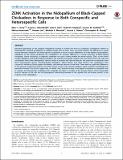Files in this item
ZENK activation in the nidopallium of black-capped chickadees in response to both conspecific and heterospecific calls
Item metadata
| dc.contributor.author | Avey, Marc | |
| dc.contributor.author | Bloomfield, Laurie | |
| dc.contributor.author | Elie, Julie | |
| dc.contributor.author | Freeberg, Todd | |
| dc.contributor.author | Guillette, Lauren | |
| dc.contributor.author | Hoeschele, Marisa | |
| dc.contributor.author | Lee, Homan | |
| dc.contributor.author | Moscicki, Michele | |
| dc.contributor.author | Owens, Jessica | |
| dc.contributor.author | Sturdy, Christopher | |
| dc.date.accessioned | 2014-07-04T16:01:07Z | |
| dc.date.available | 2014-07-04T16:01:07Z | |
| dc.date.issued | 2014-06-25 | |
| dc.identifier | 130148250 | |
| dc.identifier | 4624c257-0692-4cb0-8b22-633689e0e687 | |
| dc.identifier | 24963707 | |
| dc.identifier | 24963707 | |
| dc.identifier | 84903540013 | |
| dc.identifier.citation | Avey , M , Bloomfield , L , Elie , J , Freeberg , T , Guillette , L , Hoeschele , M , Lee , H , Moscicki , M , Owens , J & Sturdy , C 2014 , ' ZENK activation in the nidopallium of black-capped chickadees in response to both conspecific and heterospecific calls ' , PLoS One , vol. 9 , no. 6 , e100927 . https://doi.org/10.1371/journal.pone.0100927 | en |
| dc.identifier.issn | 1932-6203 | |
| dc.identifier.uri | https://hdl.handle.net/10023/4955 | |
| dc.description.abstract | Neuronal populations in the songbird nidopallium increase in activity the most to conspecific vocalizations relative to heterospecific songbird vocalizations or artificial stimuli such as tones. Here, we tested whether the difference in neural activity between conspecific and heterospecific vocalizations is due to acoustic differences or to the degree of phylogenetic relatedness of the species producing the vocalizations. To compare differences in neural responses of black-capped chickadees, Poecile atricapillus, to playback conditions we used a known marker for neural activity, ZENK, in the caudal medial nidopallium and caudomedial mesopallium. We used the acoustically complex ‘dee’ notes from chick-a-dee calls, and vocalizations from other heterospecific species similar in duration and spectral features. We tested the vocalizations from three heterospecific species (chestnut-backed chickadees, tufted titmice, and zebra finches), the vocalizations from conspecific individuals (black-capped chickadees), and reversed versions of the latter. There were no significant differences in the amount of expression between any of the groups except in the control condition, which resulted in significantly less neuronal activation. Our results suggest that, in certain cases, neuronal activity is not higher in response to conspecific than in response to heterospecific vocalizations for songbirds, but rather is sensitive to the acoustic features of the signal. Both acoustic features of the calls and the phylogenetic relationship between of the signaler and the receiver interact in the response of the nidopallium. | |
| dc.format.extent | 10 | |
| dc.format.extent | 1478586 | |
| dc.language.iso | eng | |
| dc.relation.ispartof | PLoS One | en |
| dc.rights | © 2014 Avey et al. This is an open-access article distributed under the terms of the Creative Commons Attribution License, which permits unrestricted use, distribution, and reproduction in any medium, provided the original author and source are credited. | en |
| dc.subject | QL Zoology | en |
| dc.subject.lcc | QL | en |
| dc.title | ZENK activation in the nidopallium of black-capped chickadees in response to both conspecific and heterospecific calls | en |
| dc.type | Journal article | en |
| dc.contributor.institution | University of St Andrews.School of Biology | en |
| dc.contributor.institution | University of St Andrews.Centre for Social Learning & Cognitive Evolution | en |
| dc.identifier.doi | 10.1371/journal.pone.0100927 | |
| dc.description.status | Peer reviewed | en |
This item appears in the following Collection(s)
Items in the St Andrews Research Repository are protected by copyright, with all rights reserved, unless otherwise indicated.

